- Register
- Log in to Tune-In
- Wishlist (0)
-
Shopping cart
(0)
You have no items in your shopping cart.
Beatles News

Liverpool’s Beatles -themed Hard Days Night hotel has been named the best hotel in the UK in the 2017 Travel Republic Awards. The awards are based on customer scores posted on the travel booking firm’s website. Hard Days Night is said to have prevailed because of its customer service.
The hotel’s general manager Stephen Fernley said: “It’s great to see our hotel being applauded on both a local and global scale, and it makes me feel so proud of our dedicated team members, who go above and beyond to make each guest’s stay enjoyable and highly memorable.” The hotel, situated on North John Street, offers Beatles fans from outside Liverpool great access to the Cavern Club and other Beatles-themed bars and attractions on Mathew Street.
Since opening in February 2008 for Liverpool’s year as the European Capital of Culture, the hotel has experienced several significant brushes with celebrity.
The Voice UK judge Jennifer Hudson posted a series of selfies from the hotel last year when she jetted into Liverpool for R&B star Ciara’s wedding. It’s believed she stayed in the luxurious Lennon suite.
By: Liam O'Brien
Source: The Liverpool Ec details

Musician Sean Lennon has released a song he co-wrote with late Star Wars actress Carrie Fisher. The track, titled Bird Song, was penned "years ago" by Fisher, Lennon – the son of John Lennon and Yoko Ono – explained in a note on Soundcloud.
He said he felt the need to record the unreleased song following Fisher's death from a heart attack in December, aged 60. "Carrie and I used to stay up 'til dawn chatting and pontificating about life. They were my best moments," Lennon, 41, wrote.
"Anyway, we wrote a song about staying up too late and hearing the birds sing... The lyrics she wrote with me I think are marvellous." Willow Smith, the 16-year-old daughter of Hollywood stars Will Smith and Jada Pinkett-Smith, contributed vocals to the unmixed recording.
"It's all so wrong to greet the dawn / The birds sing that awful song, saying 'You don't belong here!'" go Fisher's lyrics, over a tinkling piano and lilting harmonies that are more than a little Beatles-esque.
By: Rob Moran
Source: Sydney Morning Herald
details
“Strawberry Fields Forever” and “Penny Lane” were an early clue to a new direction. The first songs that opened The Beatles' contribution to the summer of love bridged the gap between the experiments of Rubber Soul and Revolver and the massively ambitious George Martin production that became Sgt. Pepper's Lonely Hearts Club Band. Both songs were originally the twin pillars of that album but the Beatles had a policy of leaving off pre-released singles because they were “filler” material. But there’s nothing to get hung about, there is an unsubstantiated rumor going round that an upcoming re-release of the Beatles’ classic album will remedy that. No worries, though, the rumors give us reason to explore the childhood memory song couplet by songwriters John Lennon and Paul McCartney.
The Mirror of London reported that “Strawberry Fields Forever” and “Penny Lane” will be included on the Sgt Pepper’s Lonely Hearts Club Band 50th anniversary reissue when it comes out on June 1. While the story has since been questioned, there is no question that the songs were a centerpiece of the album whether they were included or not. Fans were angry that the song details
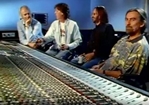
In the mid-Nineties, while Paul McCartney, George Harrison and Ringo Starr were working on the Beatles' massive Anthology project, they got together with George Martin, their old producer, at Abbey Road Studios to discuss and dissect a few classic Beatles tracks. In the incredible clip below, you can watch as they go through the various parts of John Lennon's Revolver masterpiece, "Tomorrow Never Knows," a song that signaled the band's new direction for 1966.
At the 1:10 mark, watch as Martin and McCartney grab the faders to reveal the many different layers of "Tomorrow Never Knows." "People tend to credit John with the backwards recordings, the loops and the weird sound effects, but the tape loops were my thing," McCartney says in Barry Miles' Many Years From Now. "The only thing I ever used them on was 'Tomorrow Never Knows.' It was nice for this to leak into the Beatle stuff as it did. We ran the loops and then we ran the track of 'Tomorrow Never Knows' and we played the faders, and just before you could tell it was a loop, before it began to repeat a lot, I'd pull in one of the other faders, and so, using the other people, 'You pull that in there,' 'You pull that in,' we did a half random, half orchestrated playing details

To hear Olivia Harrison tell it, it wasn't unusual for George Harrison to stroll through the house spouting words at random — a process that could cause an outsider to wonder whether the ex-Beatle had suddenly started speaking in tongues.
“George would throw out words one after another,” she said in a recent interview. “He knew he’d find the word. He was good at that. Sometimes he was quiet and just thought about it, sometimes he just kept writing down words that began with ‘S’ until he got the right one. … It didn’t matter what they were — he knew he would get to something.” In fact, that method is exactly what helped him get to Something — and While My Guitar Gently Weeps, Here Comes the Sun, Give Me Love, Give Me Peace on Earth, My Sweet Lord, Awaiting on You All, Brainwashed and so many other songs he wrote in the Beatles and as a solo artist.
Olivia Harrison had good reason to recall that detail. She’s been deep in her husband’s writing for months, culling scraps of paper, notebook entries, scribbles on hotel stationery, napkins and other bits of writing surfaces for the new “extended edition” of Harrison’ details

My sophomore year of high school, I decided to make a mockumentary about my experiences in marching band that fall. Somehow I convinced my good-natured band teacher, Mr. Moore, to let me film all kinds of footage during my down time and then show the finished film during class at the end of the semester. When I was looking for an opening credits song, my dad half-jokingly suggested the Paul McCartney & Wings song “Band on the Run” from their hit 1973 album of the same name. Though the song alludes to a band of criminals on the run, I liked the idea of interpreting it as an ode to marching band members running around a football field. I was hooked immediately by its dramatic yet playful structure. Twelve years and one music degree later, Band on the Run has become one my favorite albums, never failing to delight and surprise me with its ever-changing sound and occasionally kooky lyrics.
Wings was Paul and Linda McCartney’s pet project from 1971-1981 with a revolving door of members save for former Moody Blues guitarist Denny Laine. After struggling to impress critics and die-hard Beatles fans with their first two albums, Wings finally had a hit with “Live and Let Die,” for the 1973 James details

Two of the Beatles ’ most famous songs will finally be included on Sgt Pepper’s Lonely Hearts Club when the album is re-issued on June 1 to mark 50 years since its release.
Despite being written specifically for their eighth studio album, record label EMI chose to put out Strawberry Fields Forever and Penny Lane as a double A side single. Fans were furious it never made the final collection. Regarded as one of the best albums of all time, Sgt Peppers Lonely Hearts Club won four Grammy awards, including making history as the first rock collection to be named Album Of The Year.
The album was based on a concept by Sir Paul McCartney to record as the fictional Sgt Pepper group and encouraged them to push creative boundaries after they gave up touring. The results were classic tracks With A Little Help From My Friends and Lucy In The Sky With Diamonds. But at the time The Beatles lost a battle with their label to keep Strawberry Fields Forever and Penny Lane on the collection.
Talking about the tracks Sir Paul, 74, said: “ John write this absolutely amazing song Strawberry Fields Forever for the new album and I was frankly a bit jealous so I went home and wrote Penny Lane. “We wanted t details

Entering to the strains of Billy J. Kramer’s version of Lennon & McCartney’s Do You Want to Know a Secret; actor Ian Sexon takes the audience on a blisteringly paced account of the life of Neil Aspinall. A man at the very heart of The Beatles’ story, a man who shared their brightest and darkest moments, a man, who, unlike almost everyone else associated with the group, took his secrets to the grave.
Aspinall went from school pal of Paul McCartney and George Harrison to trainee accountant to first ever roadie, driving his beat-up Commer van the length of the country, to CEO of Apple Corps, The Beatles’ global business conglomerate. Notably, in helping to sustain The Beatles’ legacy, it was Aspinall who masterminded the creation of the world-wide, best-selling, Beatles Anthology documentary, three-volume double album and book.
Davide Verazzani’s A Life With The Beatles seeks to shed light on some of the most famous moments in the band’s history, most notably, the ground-breaking and quite frankly, bizarre, making of Sgt. Peppers Lonely Hearts Club Band.
Source: The Reviews Hub
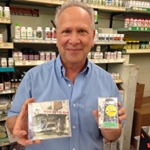
For this week's CL cover story, "Mammal Gallery braces for an unwritten future," Richard Miller relived the moment former Beatles singer and bass player Paul McCartney wandered into his South Broad drugstore. Here is his story.
"He was here at the Merchandise Mart watching his daughter Stella sell some of her wears. She made dishes and such, and he was here with his son James watching. They got bored and wanted to go check out 'the funky side of town' — Little Five Points. He got into a limousine with his son James, and he must've told the driver, 'Take us to Five Points,' which is just a block from the drugstore. So the limousine driver pulled up in front of the store because the next block is not available for cars. Paul got out of the limousine and saw a display for a product we carry called Run Devil Run in our window and said, 'Oh, that’s a cool thing, let’s go in and see what it’s all about.'
We didn’t quite realize who he was when he and James came in. They were dressed all in black — black hat, black sunglasses, black clothes. Paul walked up to the counter and asked Diane, what is this Run Devil Run? And she told him it was aromatherapy for depression. He said, 'My wif details
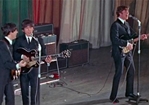
Ron Howard’s 2016 documentary The Beatles: Eight Days a Week offered an unprecedented look at the group’s touring years from 1963 through 1966. Among the many rare snippets was color footage recorded at a November 20, 1963, date at the ABC Cinema in Manchester, England. That clip is a Beatles fan’s dream. High-quality color footage of the group from before its February 1964 arrival in the U.S. is hard to come by. What’s readily available is mostly in black and white and often has poor audio quality.
The Manchester clip is an exception. It was created by Pathé News for the short feature The Beatles Come to Town and features performances of “She Loves You” and “Twist and Shout.” The film was shot in Technicolor and Techniscope (a budget widescreen process from the period) and features good-quality audio. Even without the benefit of modern restoration, it makes for enjoyable viewing. The film was originally shown in British theaters during the week of December 22, 1963, as a preview to the daily feature.
While it’s great to see the ABC Theater footage restored and included in Howard’s film, the performance of “She Loves You” is broken up details

Nearly 15 years after his death, the legacy of George Harrison and his fellow Beatles continues to reveal itself. At the moment, it's in the form of a rare black-and-white photograph in the hands of Olivia Harrison, wife of the late singer-guitarist: It shows the early Beatles posing with their instruments in a barren stretch of Liverpool, England, dressed in matching suits but still looking tough behind their smiles.
"Look at the tones in John's face," Olivia says, marveling at the image of a young John Lennon. She is sitting with family friend Nicholas Roylance, publisher at U.K.-based Genesis Publications, who hands her a batch of smaller pictures of George, capturing him as both a Beatle and solo artist. "Where did that come from?" Olivia says, examining one of the pictures. "That's super cute."
Her ongoing mission to excavate, catalog and share the long musical history of her husband is never-ending, and has already led to her co-producing the acclaimed 2011 documentary George Harrison: Living in the Material World, directed by Martin Scorsese. Now comes the expanded reissue of his 1980 book, I Me Mine, a casually intimate memoir and collection of lyrics. The book and a meticulously crafted vinyl box set of details
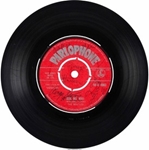
A 45 rpm copy of the second single released in the United Kingdom by all four members of the Beatles is expected to earn top lot honors at Heritage Auctions’ Entertainment & Music Memorabilia Signature Auction March 18 in Dallas.
The record includes recordings of Ask Me Why and Please Please Me (est. $40,000). John Lennon, Paul McCartney, George Harrison and Ringo Starr all signed the Ask Me Why B-side of the record; McCartney and Harrison also signed the reverse side, which features an A-side recording of Please Please Me. Given to its original owner at the Cavern Club in Liverpool, the single was released Jan. 11, 1963, 13 days before a signing session at the NEMS record shop, where the signatures likely were acquired.
A photo of the Fab Four signed by all four members of the band (est. $18,000) also is expected to draw heavy interest at the auction. The 8-by-10 glossy black-and-white picture, taken in early 1965 in the Bahamas, is signed with a felt-tip pen and includes a certificate of authenticity from Heritage Auctions and Tracks LTD.
An original pressing of the Help! Album Signed by John Lennon, Paul McCartney and George Harrison of the Beatles (Capitol MAS 2386, 1965), (est. $12,000) wi details
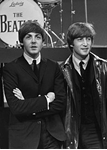
It was the first Beatles record I bought, but it wasn’t my favorite Beatles song.
I’d heard “She Loves You” in the fall of 1963, and, while the buddy I first heard it with (a story I have related before) mocked the song (as did the deejay who introduced it), I’d been immediately smitten, though I diplomatically kept my opinion to myself. Thereafter, when I listened to far away radio stations in big cities like Chicago and New York on my transistor radio at night when I was supposed to be going to sleep, I listened for “She Loves You.”
I think I may have heard it twice between that first time and the advent of what we know as Beatlemania. I freely admit that my memory of this period is fuzzy. I was in my 12th year and between the time I first heard “She Loves You” in mid-November and when I began hearing “I Want to Hold Your Hand” and other Beatles songs November 22, 1963 happened. Like most Americans I walked around in a dull daze for a while, so I hope I may be forgiven for an imperfect memory of the timeline of events.
So, Christmas 1963 came and went. I got several replacement batteries for my transistor radio among my presents which ke details

Once dubbed “Beardsley in blue jeans”, the artist Alan Aldridge, who has died aged 73, created some of the most enduring pop imagery of the 1960s and 70s. His illustration of the Who on their second album A Quick One (1966) was a distinctive period piece in which huge song titles swirled out from the musicians’ instruments and earned him a Grammy nomination. His poster for the 1966 Andy Warhol film Chelsea Girls, featuring the naked 16-year-old model Clare Shenstone adorned with suggestive artistic enhancements, was a notorious tour de force that briefly threatened to get Aldridge arrested on pornography charges.
He later formed a close working relationship with the Beatles and their Apple Corps company, and one of his best-known projects was The Beatles Illustrated Lyrics (1969), which featured Aldridge’s reality-warping artistic interpretations of such songs as Yellow Submarine, Nowhere Man and A Hard Day’s Night. A second volume was published in 1971. Aldridge was appointed “His Royal Master of Images to their Majesties the Beatles” by John Lennon. His catalogue was further embellished by posters for the Rolling Stones and the sleeve for Cream’s album Goodbye Cream (196 details

They are the biggest band in pop music history and usually credited with being the most influential. But in reality The Beatles were an average group who did little to change the musical landscape – at least according to one academic, who claims to have the science to back it up. Despite the Fab Four’s 600 million record sales, Professor Armand Leroi dismisses their output as ‘ditties for prepubescent girls’ and claims they ‘sat out’ the musical revolution of the 1960s.
His findings come not from a background in music, but from evolutionary biology. ‘As fruit flies evolve, so too does pop,’ he says. ‘Every new song comes with its own burden of mutations. Some of them bad, but a few of them flourish and get passed on to future generations. Listen carefully, and you can hear the music evolve.’ Not surprisingly, the heretical suggestions have drawn the ire of Beatles fans, including music expert Paul Gambaccini who blasts Prof Leroi as ‘preposterous’, threatening to ‘dissect him like a fly’ in a head-to-head debate.
The academic, from Imperial College London, used computer algorithms to analyse singles from every major b details
